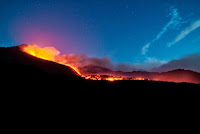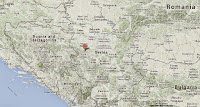Two people have died and a further eight have been treated for injuries following an Earthquake off the west coast of the Greek island of Lefkada in the Ionian Sea on Tuesday 17 November 2015. The United States Geological Survey recorded the event as having a Magnitude of 6.5 and a depth of 11 km, and occurring about 3 km offshore at about 9.10 am local time (about 7.10 am GMT). Both of the fatalities, who are recorded to have been elderly women killed in separate incidents in the villages of Vasiliki and Athani, and all of the injuries occurred on the island of Lefkada, where the Earthquake caused numerous landslides and destroyed a large number of houses, mainly on the southwest of the island, as well as at least one church. However the event was felt across much of western Greece, and damage has also been reported on Ithica, where about 40 houses were damaged and several small landslides reported, and Kefalonia, where about 10 houses have been damaged, mostly on the north of the island. The area has been rocked by a number of aftershocks following the initial event.
Damage to a house in the village of Dragano on Lefkada, Dragano is thought to be the worst affected village on the island, with most of the houses currently considered uninhabitable. My Lefkada.
Southern Greece is located on the Aegean Sea Plate, a small tectonic
plate caught between the African Plate to the south, the Anatolian Plate
to the east and the Eurasian Plate to the northwest. The Anatolian
Plate is being pushed to the west by the northward movement of the
Arabian Plate to the east, pushing the Aegean Plate south and west into
collision with the northward moving African Plate. Part of the African
Plate is being subducted beneath the Aegean Plate along the Hellenic
Trench, which runs to the south of the Greek Islands from Cyprus to
Crete then northwest under the Ionian sea parallel to the Peloponnesian
Coast. This is not a smooth process, as the plates frequently stick together
then break apart once the pressure has built up sufficiently, leading to
(fairly frequent) Earthquakes.
 One person dead following Magnitude 5.4 Earthquake in northern Azerbaijan. The United States Geological Survey recorded
a Magnitude 5.4 Earthquake at a depth of 13 km in northern Azerbaijan
slightly before 9.50 am local...
One person dead following Magnitude 5.4 Earthquake in northern Azerbaijan. The United States Geological Survey recorded
a Magnitude 5.4 Earthquake at a depth of 13 km in northern Azerbaijan
slightly before 9.50 am local...
 Volcanic activity on Mount Etna. The Osservatorio Etneo at the Istituto Nazionale di Geofisica e Vulcanologia
reported the beggining of a new phase of volcanic activity on Mount
Etna, an active volcano on the island of Sicily beginning on Tuesday 12
May 2015 with a series of Earth tremors beneath...
Volcanic activity on Mount Etna. The Osservatorio Etneo at the Istituto Nazionale di Geofisica e Vulcanologia
reported the beggining of a new phase of volcanic activity on Mount
Etna, an active volcano on the island of Sicily beginning on Tuesday 12
May 2015 with a series of Earth tremors beneath...
 Magnitude 3.9 Earthquake in western Serbia. The United States Geological Survey recorded
a Magnitude 3.9 Earthquake at a depth of about 6 km, in the Kolubara
District of western Serbia slightly after 9.45 pm local time (slightly
after 8.45 pm GMT) on Sunday...
Magnitude 3.9 Earthquake in western Serbia. The United States Geological Survey recorded
a Magnitude 3.9 Earthquake at a depth of about 6 km, in the Kolubara
District of western Serbia slightly after 9.45 pm local time (slightly
after 8.45 pm GMT) on Sunday...
The approximate location of the 17 November 2015 Lefkada Earthquake. Google Maps.
Witness
accounts of Earthquakes can help geologists to understand these events,
and the structures that cause them. The international non-profit
organization Earthquake Report is interested in hearing from people who may have felt this event; if you felt this quake then you can report it to Earthquake Report here.
See also...
 One person dead following Magnitude 5.4 Earthquake in northern Azerbaijan. The United States Geological Survey recorded
a Magnitude 5.4 Earthquake at a depth of 13 km in northern Azerbaijan
slightly before 9.50 am local...
One person dead following Magnitude 5.4 Earthquake in northern Azerbaijan. The United States Geological Survey recorded
a Magnitude 5.4 Earthquake at a depth of 13 km in northern Azerbaijan
slightly before 9.50 am local...  Volcanic activity on Mount Etna. The Osservatorio Etneo at the Istituto Nazionale di Geofisica e Vulcanologia
reported the beggining of a new phase of volcanic activity on Mount
Etna, an active volcano on the island of Sicily beginning on Tuesday 12
May 2015 with a series of Earth tremors beneath...
Volcanic activity on Mount Etna. The Osservatorio Etneo at the Istituto Nazionale di Geofisica e Vulcanologia
reported the beggining of a new phase of volcanic activity on Mount
Etna, an active volcano on the island of Sicily beginning on Tuesday 12
May 2015 with a series of Earth tremors beneath... Magnitude 3.9 Earthquake in western Serbia. The United States Geological Survey recorded
a Magnitude 3.9 Earthquake at a depth of about 6 km, in the Kolubara
District of western Serbia slightly after 9.45 pm local time (slightly
after 8.45 pm GMT) on Sunday...
Magnitude 3.9 Earthquake in western Serbia. The United States Geological Survey recorded
a Magnitude 3.9 Earthquake at a depth of about 6 km, in the Kolubara
District of western Serbia slightly after 9.45 pm local time (slightly
after 8.45 pm GMT) on Sunday...
Follow Sciency Thoughts on Facebook.


